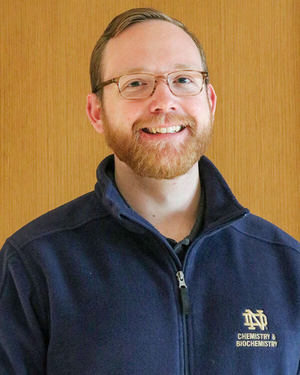
Jeffrey DuBose is a fifth-year graduate student advised by Prof. Prashant Kamat in the Department of Chemistry and Biochemistry. He presented "Controlling Energy Transfer in Nanocrystal-Chromophore Complexes" at the ND Energy PD&GS Seminar in November 2021.
After receiving a Patrick and Jana Eilers Graduate Student Fellowship for Energy Related Research in 2020, DuBose was awarded the 2021 Forgash Fellowship for Graduate Student Research in Solar Energy. His recent research has focused on the use of lead halide perovskites, a class of synthetic materials which are useful in converting solar energy directly into electricity (photovoltaics) or chemical fuels (photocatalysis).
The major goal of DuBose’s research project was to understand the fundamental steps that occur after a halide perovskite nanocrystal absorbs light. Particularly, DuBose and his collaborators in the Kamat group are interested in where the energy goes and if it can be harvested to do useful work.
“We sought to establish what parameters control the mechanism of interaction to start to build a system that mimics photosynthesis,” DuBose said.
Through careful spectroscopic measurements, the group was able to demonstrate that perovskite nanocrystals deliver their energy to a molecular chromophore, in this case rhodamine B, through a singlet energy transfer process.
“This means that after energy transfer, the electron spins of the excited molecular chromophore are opposite to another, which dictates the lifetime of the excited state and ultimately what further reactions are possible,” DuBose said.
The group leveraged halide ion exchange chemistry to develop an inventive method to study the mechanism of energy transfer. The light absorption and emission properties of perovskites are easily modified by adding a source of halogen ions. Using this technique, they studied how the perovskite-chromophore interactions changed as a function of halide content, which revealed that the singlet energy transfer process occurs through a long-range Förster mechanism.
“This level of information is crucial for fully optimizing energy transfer systems for renewable energy applications,” DuBose said.
Unexpectedly, the group discovered that certain perovskite nanocrystals were undergoing an undesired change in morphology, or size and shape, during initial experiments. Rather than being discouraged by this undesired result, DuBose took the opportunity to further investigate why these nanoparticles were undergoing a transformation.
“This was a great example of how a ‘problem’ or a negative result can actually be turned into a new research opportunity to answer questions that are important in a field,” DuBose said.
For the spin-off project, DuBose was able to work closely with undergraduate student and ND Energy Slatt scholar Andrew Christy, who co-authored a publication on this work titled, “Transformation of Perovskite Nanoplatelets to Large Nanostructures Driven by Solvent Polarity.”
“We dug into the mechanism of the phase transformation and discovered that certain polar molecules or increased temperature was causing the phase transformation,” DuBose said. “We were then able to describe the thermodynamics of the process and suggest ways to mitigate the unwanted morphology change.”
In 2021, DuBose was awarded the Experiment Physical Chemistry Award for Excellence in Graduate Research from the American Chemical Society. At the award symposium this past fall, he gave a talk on the energy transfer research highlighted here.
“This research provides a groundwork for understanding and chemically modifying these systems to harness more light for solar cells, or to create chemical fuels,” DuBose said. “The results from this research directly provide scientists and engineers better design rules for harnessing solar energy in artificial photosynthesis applications which can be used to provide renewable solar energy.”
The solar energy field is already experiencing a great deal of growth due to record low prices for solar panels, and lead halide perovskites have the potential to drive these prices even lower with their low cost and superior efficiency.
“With global energy demand quickly increasing, the world will need more renewable and clean energy solutions within the global energy portfolio to offset the environmental impact of greater energy demand,” DuBose said.
DuBose is currently interviewing for post-doctoral research positions at several universities and national laboratories. He will continue to research renewable energy; however, he intends to shift focus from light-induced processes (photochemistry) to voltage-induced processes (electrochemistry).
“My goal is to hone my skills in electrochemistry and prepare myself for an independent career in science, either in a university or national laboratory setting,” DuBose said.
DuBose has been developing his pedagogy by creating video lectures on measurement techniques that are relevant to energy research. In the future, he hopes to continue developing his pedagogy and mentorship in his independent career.